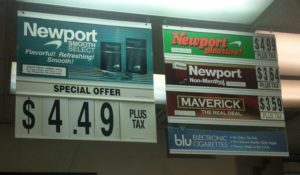San Francisco residents have voted to uphold a city-wide ban on all flavored tobacco products, including menthol cigarettes.
The San Francisco City Council and Health Committees unanimously passed the menthol restriction ordinance in June 2017, and it was approved by then Mayor Ed Lee. However, the tobacco industry very quickly moved to stop implementation by collecting signatures. The tobacco industry paid petition-gatherers $5 per signature in order to collect the needed 20,000 signatures to force the ordinance restricting the sale of their deadly products into referendum. Despite R.J. Reynolds spending nearly $12 million on campaigns against the ordinance, advocates of the policy continued to engage the community and work towards a positive outcome. On June 5, 2018, 68% of San Francisco residents voted “Yes” on Proposition E, upholding the policy.
Menthol is the only flavor excluded from the 2009 federal ban on flavored cigarettes as part of the Family Smoking Prevention and Tobacco Control Ac (FSPTCA). The tobacco industry targets African-American and LGBTQ communities in particular with menthol cigarette advertisements and products. Youth are particularly targeted when it comes to other flavored tobacco products, such as cigarillos and e-cigarettes, which are included in the ban.
San Francisco is the first city to prohibit the sales of all flavored tobacco products, including menthol cigarettes, without exemption, leading the way as they have done with tobacco retailer density policies. While other localities across the country have implemented policies prohibiting or restricting sales of flavored tobacco, most have exempted menthol cigarettes. Those that have included menthol, such as those in Chicago and Berkeley, only restrict the sale of the product near schools. Others exempt tobacco specialty stores or exempt cigarettes. The only other locality to pass a comprehensive ban is Yolo County, CA , which in November 2016 became the first county in the country to pass a policy banning the sale of all flavored tobacco products in any tobacco retailer in the unincorporated areas of the county.
Learn more about the groundwork that was key to getting this policy passed in the San Francisco ban here.
Policy Impact

The 2009 FSPTCA ban on flavored cigarettes was associated with a 17% reduction in the probability of middle and high school youth becoming smokers and a 58% reduction in cigarettes smoked by current youth smokers.[1] However, the ban was also associated with an increase 45% increase in use of menthol cigarettes, a 34% increase in use of cigars, and a 55% increase in use of pipes, indicating that youth may be substituting menthol cigarettes and other flavored tobacco products in place of flavored cigarettes.[1] Overall, the probability of youth using any form of tobacco dropped by 6% following the ban on flavored cigarettes, showing the impact that restrictions on flavored tobacco products can have.[1] However, the increases in use of other products that are commonly flavored is concerning and points towards the potential impact that more comprehensive restrictions on flavored tobacco, like the one passed in San Francisco, could have on youth tobacco use.
You can also learn more about Menthol, Flavored Tobacco, and tobacco industry’s targeted advertising from the following links:


